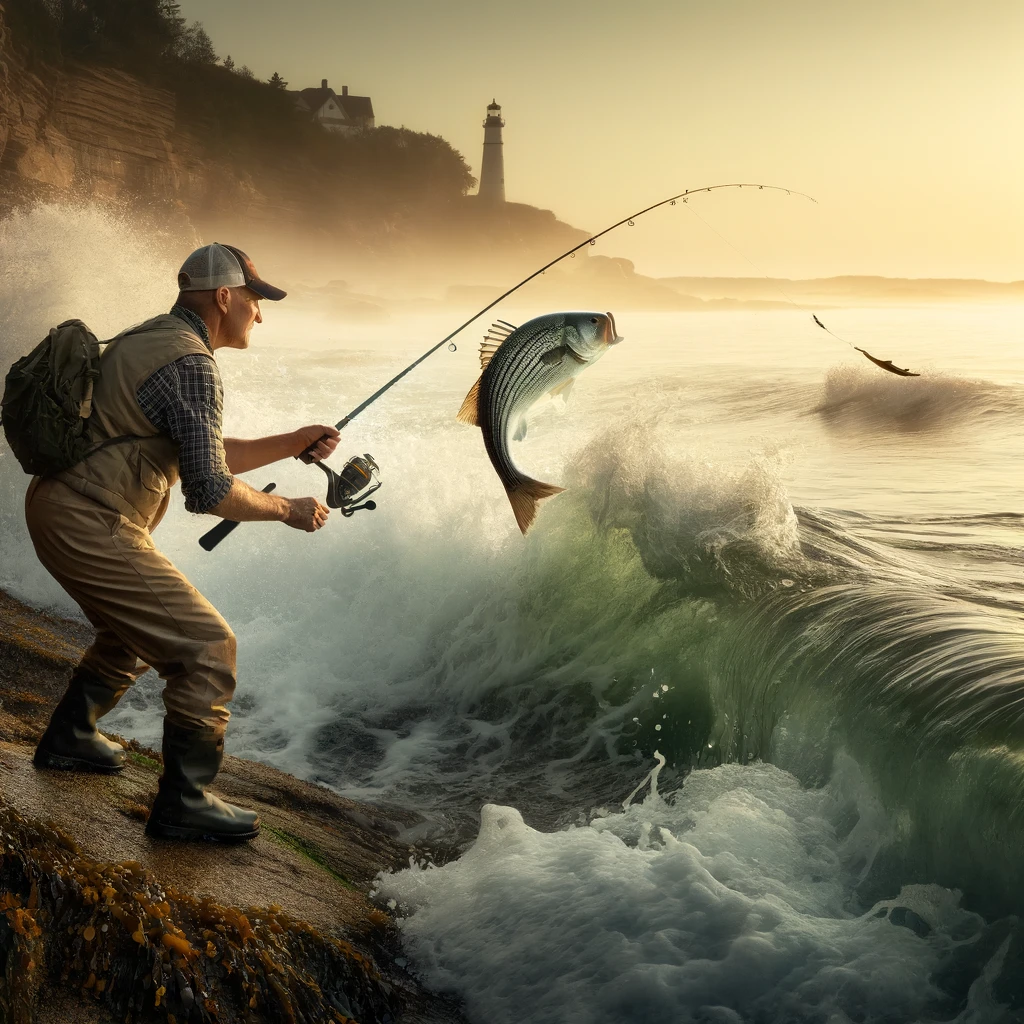A Guide to Successful Bass Fishing

In the realm of angling, few pursuits rival the exhilaration of hooking into a robust striped bass. Revered for their formidable fight and prized for their succulent flesh, these sleek predators command the attention of anglers across coastal waters. Yet, amidst the vast array of lures and baits adorning tackle boxes, discerning the most effective options for enticing these elusive gamefish can be a daunting task. In this comprehensive guide, we delve into the art and science of striper fishing, unveiling the top baits revered by seasoned anglers for their prowess in tempting these formidable denizens of the deep. From time-tested classics to innovative offerings, join us on a journey through the waters to discover the baits that reign supreme in the pursuit of striped bass mastery.
Live Baits: Nature’s Temptations
Live bait has long been hailed as the pinnacle of temptation in the pursuit of striped bass. Its natural movements and scent profile are unparalleled in their ability to elicit strikes from even the most discerning of predators. Among the pantheon of live baits, few can rival the effectiveness of bunker, also known as menhaden. These oily, silver-sided baitfish are a staple in the diet of striped bass, making them a prime choice for anglers seeking to capitalize on the bass’s natural foraging instincts.
When presenting bunker as live bait, anglers often opt for a variety of rigging techniques to maximize their effectiveness. One popular method involves employing a fishfinder rig, which allows the bunker to swim freely while remaining securely attached to the line. This setup not only provides a natural presentation but also allows the baitfish to move about in a lifelike manner, enticing nearby stripers to strike.
Another live bait option that commands attention from striped bass is the venerable eel. Renowned for its sinuous movements and irresistible scent, the eel is a favorite among anglers targeting trophy-sized bass. Whether fished on the surface with a float or presented along the bottom, eels possess an inherent allure that can provoke aggressive strikes, particularly during low-light conditions or when targeting larger specimens prowling in deeper waters.
In addition to bunker and eels, a variety of other live baits can prove effective in enticing striped bass. Mackerel, herring, and mullet are all popular choices, each offering its own unique appeal to discerning bass. Ultimately, the key to success with live bait lies in presenting the baitfish in a natural manner and allowing their inherent characteristics to shine.
However, it’s essential for anglers to exercise caution and ensure the ethical treatment of live bait. Proper handling and storage techniques are crucial for maintaining the health and vitality of baitfish, thereby maximizing their effectiveness on the water. Additionally, local regulations may dictate specific guidelines regarding the use of live bait, including restrictions on certain species or size limits. By adhering to these guidelines and respecting the delicate balance of the marine ecosystem, anglers can enjoy the thrill of live bait fishing while minimizing their impact on the environment.
Artificial Baits: Lures of Deception
In the quest to outsmart striped bass, anglers often turn to artificial baits, harnessing the ingenuity of lure designers to mimic the appearance and behavior of natural prey. From shimmering spoons to lifelike swimbaits, the arsenal of artificial baits available to today’s anglers is as diverse as it is effective. In this section, we’ll explore some of the most popular types of artificial baits used in striper fishing, along with their unique characteristics and applications.
- Topwater Lures:
- Pencil Poppers: These slender, cigar-shaped lures are designed to mimic the darting action of wounded baitfish on the surface. When retrieved with a series of sharp twitches, pencil poppers create a commotion that can attract aggressive strikes from striped bass prowling in shallow waters or feeding near the surface.
- Walk-the-Dog Lures: Featuring a slim profile and a tapered body, walk-the-dog lures are renowned for their side-to-side “walk” action when retrieved with a rhythmic twitching motion. This erratic movement closely resembles the behavior of fleeing baitfish, making walk-the-dog lures a go-to choice for enticing strikes from striped bass in a variety of conditions.
- Jigs and Bucktails:
- Bucktail Jigs: Characterized by a lead head adorned with strands of natural deer hair or synthetic fibers, bucktail jigs are versatile lures capable of imitating a wide range of prey species. Whether bounced along the bottom or retrieved through the water column, bucktail jigs possess a seductive swimming action that can trigger reflexive strikes from striped bass lurking in structure or along drop-offs.
- Soft Plastic Swimbaits: Crafted from soft, lifelike materials and molded into the shape of baitfish, soft plastic swimbaits are a favorite among anglers seeking to fool wary stripers. Available in a variety of sizes and colors, these versatile lures can be rigged weedless or on jig heads, allowing anglers to adapt their presentation to suit the prevailing conditions.
- Spoons and Metal Jigs:
- Trolling Spoons: Designed for trolling behind a boat at varying speeds, trolling spoons are characterized by their slender, concave shape and reflective finish. When trolled through schools of baitfish or along submerged structure, trolling spoons emit flash and vibration that can trigger predatory responses from striped bass patrolling the depths.
- Diamond Jigs: Resembling small fish or squid, diamond jigs are weighted metal lures equipped with a single hook and a treble hook or assist hook. Their compact profile and erratic fluttering action make them effective for vertical jigging over wrecks, reefs, or rocky outcroppings where striped bass congregate in search of prey.
Natural Baits: Harnessing the Power of Nature
While artificial lures and live baits have their place in the arsenal of striped bass anglers, there’s a timeless allure to natural baits that cannot be overlooked. From humble clams to savory squid, natural baits offer a simplicity and authenticity that can sometimes outshine their synthetic counterparts. In this section, we’ll delve into the world of natural baits and explore some of the most effective options for enticing striped bass.
- Clams:
- Whole Clams: Fresh or salted whole clams are a classic choice for anglers targeting striped bass along sandy bottoms or in estuarine environments. Their natural scent and soft texture make them irresistible to foraging bass, especially during periods of tidal movement or when fishing in areas known for their abundance of shellfish.
- Squid:
- Strips of Squid: Whether fresh or frozen, strips of squid are a versatile bait option that can be used in a variety of presentations. From threading onto a hook to tipping a jig or rigging as a teaser, squid strips emit a potent scent and possess a tantalizing texture that can provoke aggressive strikes from striped bass prowling the depths.
- Mackerel:
- Cut Bait: Freshly cut chunks or strips of mackerel are a go-to choice for anglers seeking to tempt larger striped bass with a substantial meal. Whether fished on a bottom rig, suspended beneath a float, or drifted along a rocky shoreline, mackerel cut bait exudes an oily scent and natural flavor that can trigger feeding responses from even the most wary of stripers.
- Sandworms:
- Live Sandworms: These slender, wriggling creatures are a favorite among anglers targeting striped bass in shallow water or along sandy beaches. Threaded onto a hook or presented on a dropper loop rig, live sandworms possess a tantalizing scent and lifelike movement that can entice strikes from bass foraging in the surf or scouring the shallows for prey.
- Menhaden:
- Chunk Baits: Whether fresh or frozen, chunks of menhaden, also known as bunker, are prized for their oily flesh and robust scent. Whether fished on a fishfinder rig, suspended beneath a float, or drifted along a rip current, menhaden chunks emit a potent odor trail that can draw in hungry striped bass from a distance.
Tips and Techniques: Maximizing Success on the Water
Achieving success in striper fishing requires more than just selecting the right bait; it demands a nuanced understanding of the fish’s behavior, habitat preferences, and feeding patterns. In this section, we’ll explore some essential tips and techniques that can help anglers maximize their success on the water and increase their chances of hooking into trophy-sized striped bass.
- Location, Location, Location:
- Before casting a line, take the time to research and identify productive fishing spots where striped bass are likely to congregate. Focus on areas with structure such as rocky outcrops, submerged reefs, and sandbars, as well as transitions between shallow and deep water. Additionally, pay attention to environmental factors such as water temperature, currents, and tides, as these can influence bass behavior and feeding activity.
- Timing is Key:
- Striped bass are known to be most active during low-light periods such as dawn and dusk, as well as during tidal changes and periods of increased water movement. Plan your fishing trips accordingly, aiming to be on the water during times when bass are most likely to be actively feeding. Keep in mind that seasonal variations in water temperature and baitfish migrations can also impact bass behavior, so be prepared to adapt your tactics accordingly.
- Presentation Matters:
- Whether using live bait, artificial lures, or natural baits, pay close attention to your presentation technique. Experiment with different retrieval speeds, depths, and movements to mimic the behavior of injured or fleeing prey. When fishing with live bait, avoid excessive movement that may spook wary bass, and be patient, allowing the bait to do the work of enticing strikes.
- Match the Hatch:
- Take cues from the local baitfish population and adjust your bait selection accordingly. Pay attention to the size, shape, and color of prevalent baitfish species in the area, and choose lures or baits that closely resemble them. Matching the hatch increases the likelihood of eliciting strikes from bass that are actively feeding on specific prey items.
- Stay Mobile:
- Don’t be afraid to move around and explore different fishing spots throughout the day. Bass are often on the move, so staying mobile allows you to cover more water and increase your chances of encountering actively feeding fish. Use a combination of boat positioning, drifting, and casting techniques to effectively cover a variety of habitats and depths.
Tackle Selection: Gear Up for Striped Bass Success
Selecting the right tackle is paramount for effectively targeting striped bass, as these powerful fish require sturdy gear capable of withstanding their formidable fights. In this section, we’ll explore the essential components of a striper fishing setup, including rods, reels, line, and terminal tackle, to help anglers gear up for success on the water.
- Rods:
- When choosing a rod for striper fishing, opt for a medium to heavy-action rod with sufficient backbone to handle the weight and power of striped bass. A rod length between 7 to 9 feet is ideal for casting distance and control, especially when fishing from shore or wading in the surf. Consider rods designed specifically for casting lures or bait fishing, depending on your preferred angling style.
- Reels:
- Pair your rod with a durable and reliable reel capable of handling the demands of striper fishing. Baitcasting reels or spinning reels in the size range of 4000 to 6000 are well-suited for targeting striped bass. Look for reels with smooth drag systems and ample line capacity to accommodate heavy braided or monofilament lines commonly used for bass fishing.
- Line:
- Braided line is a popular choice among striper anglers due to its superior strength, sensitivity, and abrasion resistance. Opt for braided lines in the 20 to 40-pound test range, depending on the size and fighting capabilities of the striped bass in your fishing area. Fluorocarbon leaders can be added to provide stealth and abrasion resistance, especially in clear water or when targeting wary fish.
- Terminal Tackle:
- Choose terminal tackle components tailored to your preferred fishing techniques and bait presentations. For live bait fishing, select appropriate hooks in sizes ranging from 1/0 to 7/0, depending on the size of the baitfish and the size of the bass you’re targeting. Circle hooks are popular for live bait fishing, as they are effective at hooking fish in the corner of the mouth, minimizing deep hooking and facilitating catch-and-release practices.
- When using artificial lures, stock your tackle box with a variety of jig heads, swimbait hooks, and topwater plugs to cover different depths and fishing scenarios. Experiment with different weights, colors, and sizes to match the prevailing conditions and trigger strikes from striped bass.
- Don’t forget to include essential terminal tackle accessories such as swivels, snaps, and sinkers to customize your rigs and adjust your presentations on the fly.
Conclusion:
In the dynamic world of striper fishing, success is not measured solely by the size of the catch but by the thrill of the chase and the camaraderie shared among fellow anglers. From the tranquil shores of coastal bays to the rolling swells of the open ocean, the pursuit of striped bass offers a tapestry of experiences that captivates the hearts and minds of fishing enthusiasts around the globe.
As our journey through the realm of striper fishing comes to a close, it’s evident that mastering the art and science of angling for these iconic gamefish requires a multifaceted approach. Whether deploying live baits, tempting strikes with artificial lures, or harnessing the allure of natural offerings, anglers must adapt their tactics to the ever-changing conditions of the water and the elusive nature of their quarry.
Yet, beyond the pursuit of striped bass lies a deeper connection to the natural world—a reverence for the beauty of coastal ecosystems and the intrinsic value of conservation. As stewards of these fragile habitats, anglers play a vital role in preserving the health and vitality of marine environments for future generations to enjoy.
So, as you embark on your next striper fishing adventure, may you cast with purpose, reel with determination, and savor each moment spent in pursuit of these magnificent fish. And remember, whether the day yields a trophy-sized catch or simply memories shared with friends, the true essence of striper fishing lies in the journey itself—an endless odyssey of exploration, discovery, and the boundless wonders of the sea.




